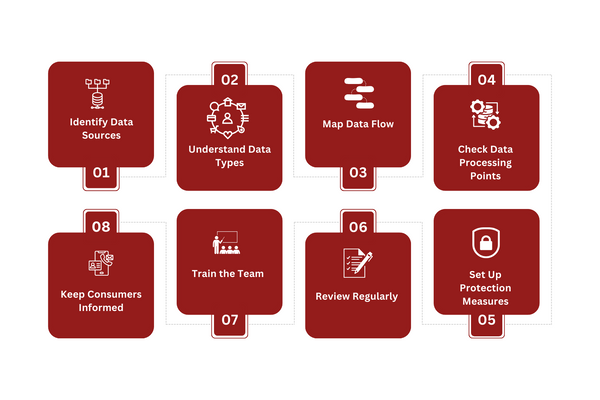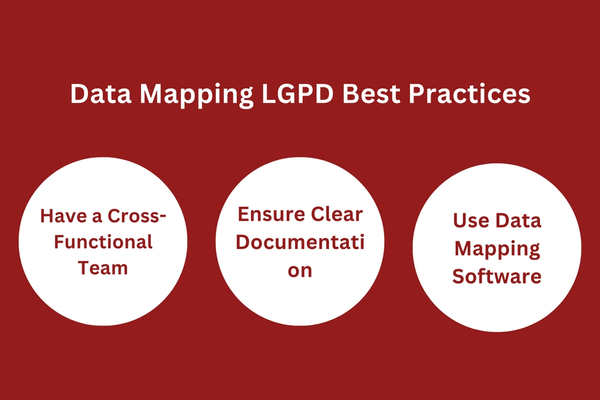
Navigating the world of data protection can be a maze, but understanding data mapping LGPD makes the journey smoother. This article will guide you and your business in the right direction if you’re wanting to understand the nuances of LGPD and the importance of data mapping.
We’ll uncover how businesses can better protect consumers’ personal data and why this is crucial in today’s digital age. Ready to set a course toward better data compliance?
Let’s dive in.
Key Takeaways
Data mapping for LGPD is an indispensable tool for businesses, allowing them to visualize and secure personal data flow, ensure they align with privacy regulations, and build consumer trust.
While LGPD data mapping has many challenges, ranging from evolving regulations to tech limitations, following best practices like having a cross-functional team and leveraging data mapping software can make things easier.
Clear documentation and transparency with consumers are vital. Keeping all stakeholders informed, both within the business and externally, ensures businesses remain compliant, and consumers stay confident about their data’s protection.
What is Data Mapping LGPD?
What is Data Mapping LGPD.png

Data mapping in the context of LGPD is more than just a technical exercise, it’s a strategic approach that businesses take to manage personal data and its flow across their operations. At its core, data mapping allows businesses to visualize how data enters, is processed, and exits their systems.
This ensures a structured data flow and aids in maintaining a high level of data protection. For businesses, understanding the intricacies of data mapping LGPD is vital.
It provides clarity about how consumer information moves, helping businesses avoid potential data breaches and ensuring that they stay in line with privacy regulations.
Why is LGPD Data Mapping Necessary?
Data mapping is like giving your business a clear roadmap of where this data goes. Without this map, businesses might get lost in the sea of data, risking data breaches or breaking privacy regulations.
But there’s another reason why LGPD data mapping is a big deal. There are rules, like LGPD and GDPR, that tell businesses how to treat consumer data. LGPD is different from the GDPR, but both are about keeping data safe. A good data map helps businesses make sure they follow these rules. If they don’t, they might face problems like fines.
Lastly, for us at Captain Compliance, it’s about trust. When businesses use data mapping, they show consumers they care about their privacy. In the long run, this trust can mean more loyal consumers and a stronger business.
How to do LGPD Data Mapping
How to do LGPD Data Mapping.png

Mapping data under LGPD might initially seem like a daunting task. However, when thought of as a puzzle, it becomes an exercise in piecing together the complete picture. Much like GDPR data mapping, the emphasis is on understanding and securing personal data. Let’s break it down step by step.
Step 1: Identify Data Sources
Every business has various touchpoints where they collect consumer data. This could be from online forms, direct emails, apps, or face-to-face chats. Understanding these sources is the starting point of any data mapping process.
With a clear sense of where data comes from, businesses can create a foundation. It’s important to set the borders of a puzzle, making the next steps more manageable.
Step 2: Understand Data Types
Data varies in type and sensitivity. Hence, it’s essential for businesses to categorize the types of personal data they handle, from names to intricate financial details.
By differentiating the data types, businesses can apply relevant security and processing measures, ensuring each data type is dealt with appropriately.
Step 3: Map Data Flow
After pinpointing sources and types, the next step is tracking the data’s journey within your business ecosystem. This could be from a shopping app to a cloud storage or confirming payment to sending payment confirmation to a customer.
Having a visual or documented representation of this flow ensures businesses always maintain oversight. It’s like tracing the journey of a river from its source to the sea.
Step 4: Check Data Processing Points
Storing data is one aspect; what’s done with it is another. Actions like validating an order, sending emails, or updating profiles involve processing.
Identifying all these points where data undergoes some action or change is crucial. It ensures businesses are fully aware of potential risk points and can apply the necessary safeguards.
Step 5: Set Up Protection Measures
Knowing the data journey is half the battle. The next step is setting up defenses. This could involve digital tools or even physical barriers, depending on the data type and storage method.
Every protection measure, be it a firewall, encryption, or secured access, fortifies the business against potential breaches, ensuring the sanctity of consumer data.
Step 6: Review Regularly
The world of data isn’t static. With new tools and changing procedures, the data landscape of a business can evolve. As such, revisiting the map is essential.
Frequent reviews and updates ensure that the data map is a living document, reflecting real-time data flows and processing points.
Step 7: Train the Team
A map, however detailed, is only as useful as the person reading it. So, beyond crafting an accurate data map, businesses must ensure their teams know how to use it.
Regular training sessions can equip teams with the knowledge and tools they need. They’ll understand the significance of data paths and the importance of their security.
Step 8: Keep Consumers Informed
Transparency isn’t just a buzzword, it’s an essential business practice. Businesses must keep their consumers updated about how their data is used and secured.
Periodic updates, be it through a refined privacy notice or newsletters, help in building and maintaining trust. It sends a clear message: consumer data privacy is paramount.
Common Challenges While Doing LGPD Data Mapping
Data mapping for LGPD compliance isn’t a walk in the park. With shifting landscapes in both technology and privacy regulations, businesses often bump into a few hiccups. Knowing these challenges ahead can better prepare businesses and smooth the journey. Here are the most common challenges while doing LGPD data mapping:
Incomplete Data Source Identification
Starting a data mapping journey, businesses might feel they’ve nailed all the data sources. However, often, hidden or overlooked sources emerge.
For instance, while they may track online forms, they might miss out on offline feedback forms. Not having a full picture can be a big hurdle, leading to incomplete data mapping and potential compliance issues.
Evolving Regulatory Landscape
Regulations such as LGPD are ever-changing, and businesses must keep up to date with the most recent changes if they want compliance. Keeping an eye out for regular updates is essential when mapping data according to these regulations.
Ensuring Data Security
With the identified data and its pathways, there’s the mammoth task of safeguarding it. The challenge here is multifold. There’s the risk of data breaches, the task of ensuring secure data processing, and maintaining high levels of data protection. As data flows through various channels, ensuring its security at each step can be daunting.
Continuous Training and Awareness
Knowledge isn’t static, especially in the compliance world. As businesses evolve, new tools and methods are introduced, altering the data flow. Training teams continuously on these changes, ensuring everyone’s on the same page, and upholding corporate compliance becomes an ongoing challenge.
Overcoming Tech Limitations
Sometimes, the challenge isn’t just regulatory. It’s technical. Legacy systems, outdated databases, or incompatible tools can make seamless data mapping tough. Migrating or updating these systems requires time, resources, and expertise.
Keeping Consumers Informed
With the emphasis on privacy, it’s not just about internal processes. Businesses have a duty to keep their consumers informed, be it through privacy notices or updates. Crafting clear, concise, yet comprehensive communications, that are easily understood by consumers, is a challenge in itself.
Cost and Resource Constraints
While many businesses understand the need for data compliance, resources can be a constraint. Whether it’s about investing in data compliance solutions or hiring experts, there’s a cost involved. Smaller businesses, especially, might find the financial demands of data mapping quite challenging.
Outsourcing Vs. In-House Challenges
To tackle data mapping, businesses have two primary routes. They either outsource compliance or manage it in-house. Each has its pros and cons. Outsourcing can seem cost-effective, but control is relinquished to a third party. On the other hand, in-house operations offer more control but demand more resources and continuous training.
Data Mapping LGPD Best Practices
Data Mapping LGPD Best Practices.png

With the digital realm expanding and privacy concerns escalating, LGPD data mapping has become non-negotiable for businesses. And while challenges might seem overwhelming, aligning with best practices can make the journey smoother and more efficient.
Let’s dive deep into some practices that businesses, both big and small, can incorporate for effective data mapping:
Have a Cross-Functional Team
A cross-functional team brings diverse perspectives and expertise. For LGPD data mapping, this means the interconnected communication of IT professionals understanding the tech landscape, legal experts interpreting privacy regulations, and business stakeholders recognizing the operational needs.
Businesses can ensure a comprehensive data map that leaves no stone unturned by involving different departments, from marketing to customer service. This collaboration not only simplifies the mapping process but also ensures a more holistic data protection strategy.
Ensure Clear Documentation
Documentation is the backbone of compliance. Every data source, every process, and every decision made should be documented meticulously. This not only aids in creating a transparent data flow but also proves invaluable during audits or reviews.
If there’s a change in process or a new data source is added, the documentation should reflect this promptly. It’s about creating a living document that evolves with the business’s data landscape, ensuring compliance at every step.
Use Data Mapping Software
While manual data mapping has its uses, leveraging data mapping software can be a game-changer. This software can automate processes, identify overlooked data sources, and ensure that updates are timely and accurate. The security features in these tools also safeguard against potential data breaches.
Given that LGPD is different from the GDPR, businesses must choose software that caters to the specific nuances of LGPD while facilitating smooth data processing. In an age of automation, these tools can significantly reduce human error, ensuring businesses are always a step ahead in their compliance plan.
Closing
Armed with the insights from this guide, businesses are in a better position to protect personal data, uphold privacy, and foster trust among consumers.
For those who feel the path ahead might still be a tad challenging, there’s good news!Captain Compliance is here to be your trusted guide. With a team of experts, state-of-the-art data compliance solutions, and a passion for ensuring businesses thrive in a compliant ecosystem, we can help you transform knowledge into actionable steps.
Whether you need advice on crafting a compliance plan, require compliance services, or are looking to outsource compliance, you can lean on us. Reach out to us today, and together, we’ll ensure that your business meets and exceeds the expectations set by LGPD and other privacy regulations.
FAQs
What is the main purpose of LGPD?
The main purpose of LGPD is to protect the privacy and personal data of Brazilian citizens. It sets out rules that businesses must follow when collecting, storing, and processing personal data.
To understand more about LGPD’s objectives and how they impact businesses, read our detailed guide on LGPD.
Are foreign businesses subject to LGPD?
Yes, if your business offers services or products in Brazil or processes the data of Brazilian residents, then LGPD applies, even if your business isn’t located in Brazil.
Not sure if your business falls under LGPD jurisdiction? We can help you assess.
What are the penalties for non-compliance with LGPD?
Non-compliance with LGPD can lead to severe penalties, including fines of up to 2% of a business’s revenue in Brazil from the prior year, capped at 50 million Brazilian Reais per violation.
Don’t risk non-compliance! Explore our services to ensure your business stays compliant.
What data does LGPD protect?
LGPD protects personal data, which includes any information that can identify a person. This includes names, addresses, email addresses, and even IP addresses or any data that, when combined, can identify an individual.
Want to know more about the types of data protection? Dive into our resources.